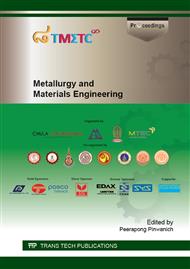p.141
p.146
p.151
p.156
p.161
p.167
p.172
p.177
p.185
The Influence of Current Density for Zinc Electrodeposition on Color Appearance of Black Trivalent Chromate Conversion Coatings
Abstract:
Chromate conversion coating is an important surface finishing process for electroplated zinc coatings that are widely employed in automotive applications. In addition to providing enhanced corrosion protection, the conversion coating offers a shade of colors to the coated products, both for aesthetic and functional benefits. Due to the stringent requirements on environmental issues, the industry is replacing the conventional hexavalent chromate with a more environmentally friendly trivalent chromate for the production of coatings. This effectively poses the requirement of the fundamental understanding on how the keys processing parameters of trivalent chromate conversion coating may relate to coloring of the coating products. In this work, for the first time, a systematic study is carried out to correlate the electroplating parameters, including the current density and electrolyte’s additives, on the formation of the trivalent chromate conversion coating, and hence the color appearance of the top-coats. Focusing on the black conversion coating, the color and optical properties are analyzed using a colorimeter and an optical spectrometer. The results notably show that, while the additives highly influence the observable shade of blackness, current density affects the optical properties in the visual spectrums. The microstructural and chemical characterization techniques, namely FE-SEM, OM, and XRD, are used to shed some light on the underlying mechanism that controls the color appearance. The understanding developed in this study will impact the design and fabrication of the electrogalvanizing products of desired color and esteemed functional performance.
Info:
Periodical:
Pages:
161-166
Citation:
Online since:
July 2015
Keywords:
Price:
Сopyright:
© 2015 Trans Tech Publications Ltd. All Rights Reserved
Share:
Citation:


